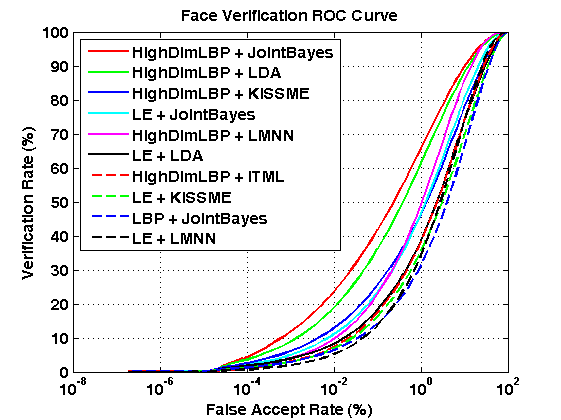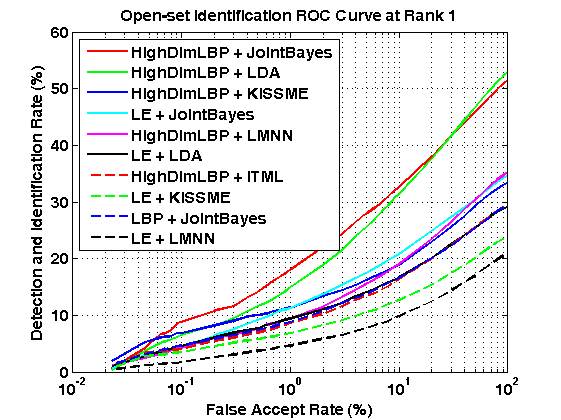Benchmark of Large-scale Unconstrained Face Recognition-blufr 算法的理解
|
Many efforts have been made in recent years to tackle the unconstrained face recognition challenge. For the benchmark of this challenge, the Labeled Faces in the Wild (LFW) [2] database has been widely used. However, the standard LFW protocol is very limited:
Thereby we develop a new benchmark protocol to fully exploit all the 13,233 LFW face images for large-scale unconstrained face recognition evaluation. The new benchmark protocol, called BLUFR, contains both verification and open-set identification scenarios, with a focus at low FARs. There are 10 trials of experiments, with each trial containing about 156,915 genuine matching scores and 46,960,863 impostor matching scores on average for performance evaluation. We provide a benchmark tool here to further advance research in this field. For more information, please read our IJCB paper and the README files in the benchmark tookit. |
||||||||||||||||||||||||||||||||||||||||||||||
|
The benchmark tookit:BLUFR.zipThe basic feature files: lfw.mat frgc.matOther available features: HighDimLBP LE --Thanks to Dong Chen |
||||||||||||||||||||||||||||||||||||||||||||||
|
Shengcai Liao, scliao@nlpr.ia.ac.cn National Laboratory of Pattern Recognition, Institute of Automation, Chinese Academy of Sciences. |
||||||||||||||||||||||||||||||||||||||||||||||
Notes: (1) Algorithms are ranked by VR @FAR=0.1%. (2) Performances are measured in (μ - σ) of 10 trials. (3) The citations indicate where the results are from. Download the result files and demo code for performance plot: Results.zip Please contribute your algorithm's performance so that we can keep a track of the state of the art for large-scale unconstrained face recognition. |
||||||||||||||||||||||||||||||||||||||||||||||
|
[1] Shengcai Liao, Zhen Lei, Dong Yi, Stan Z. Li, "A Benchmark Study of Large-scale Unconstrained Face Recognition." In IAPR/IEEE International Joint Conference on Biometrics, Sep. 29 - Oct. 2, Clearwater, Florida, USA, 2014. [pdf] [slides] [2] G. B. Huang, M. Ramesh, T. Berg, and E. Learned-Miller. Labeled faces in the wild: A database for studying face recognition in unconstrained environments. Technical Report 07-49, University of Massachusetts, Amherst, October 2007. https://blog.csdn.net/keyanxiaocaicai/article/details/51005221 现在已知的算法是lfw 有6000对,3000 对正样本,3000 对负样本,利用十重交叉验证的方式来计算识别率。 虽然在现在的lfw 数据集上已经可以达到99% 但是并不能保证在真实的场景下有比较好的性能。 作者提出了一种新的方法,主要是扩展了原来基础上只有6000 对正负样本的计算。 现在作者把lfw 数据集分成一部分训练集,一部分测试集,训练集的样本平均在3400 多张左右,训练集的选取和测试集的选取都基于一些规则(比如要求训练集有1500 个人,其中包含至少437人有2个以上的人脸,因为总共有5749 个人,所以测试集包含其余的(5729-1500)个人,大概是1243 个人有2个以上的人脸,经过测试里面含有2个人以上的人是 1680个,跟paper 里面讲的是吻合的)。 训练集对于我们的作用目前在我看来是用来求主成分分析的W 矩阵,本文要求的时候降维之后为400. 作者把原来的verfication 的任务扩展为 更接近于实际场景的verfication +DIR verfication 任务是只校验两个人脸是不是一个人。 以第一轮为例: 作者训练部分的样本为:2952 那么相应的测试部分的样本为(13233-2952)=10281 对于测试样本经过pca 之后是降低维度之后的样本,先求norm,(如果不求norm 会对结果有什么影响) 10281 个样本之间两两求相似度.(作者采用的trick是求一个下三角的方式) 这样得到是所有10281 之间样本的相似度。 我们还可以得到这些样本之间那些是一类的,那些不是一类的 我们可以得到不是一个人的总的个数和他们的计算分值。(10281*10281-10281)/2 所有对的个数 其中负样本对的个数为:52612506 正样本对的个数为:231834 我们把这些负样本的score 从大往小排,根据: thresholds(~isZeroFAR & ~isOneFAR) = impScore( falseAlarms(~isZeroFAR & ~isOneFAR) ); 这样我们得到每个falseAlarms 点处的阈值: FAR false accept ratio (是将其他人看做你的概率) 计算方法是:非同人分数>T/非同人比较次数 我的理解为:因为负样本为52612506 个,如果FAR 为0.0001 那么允许错分的样本数目为 52612506*0.0001=5261.2506个,那么由于负样本的score 是从上往下排的,所以只允许上面得分高的被错分掉, 那么阈值要设置为0.8293 那么我们可以计算 VR 就是正样本里面score>0.8293 的值, 与全部正样本的比值。 对DIR 我现在的理解为: DIR 是把测试集分成三部分:一部分是gallay set G(only one image per subject was selected),由于测试集包含1242 个人, 那么除了gallay 以外的其他的人脸组成PG, 其他的人脸组成PN, 平均下来,PG 大概有4350 张图片,PN 有3249 个人的4357 张图片。(互斥的关系) 以第五轮为例: PG 有4417 个, PN 有4053 个样本 FAR 的选取方式跟VR 的方式是一样的。阈值的选取方式。 对于PN 里面的样本,都是负样本,那么我们在每一行找一个与gallay 里面的图片相似度最高的得到一个列向量。 把这些元素降序排列, 对于face verification 这个任务,我们采用ROC 曲线来刻画。 对于DIR 这个任务,采用CMC 曲线来刻画 |
Benchmark of Large-scale Unconstrained Face Recognition-blufr 算法的理解的更多相关文章
- face recognition[翻译][深度学习理解人脸]
本文译自<Deep learning for understanding faces: Machines may be just as good, or better, than humans& ...
- 大规模视觉识别挑战赛ILSVRC2015各团队结果和方法 Large Scale Visual Recognition Challenge 2015
Large Scale Visual Recognition Challenge 2015 (ILSVRC2015) Legend: Yellow background = winner in thi ...
- Computer Vision_33_SIFT:Improving Bag-of-Features for Large Scale Image Search——2010
此部分是计算机视觉部分,主要侧重在底层特征提取,视频分析,跟踪,目标检测和识别方面等方面.对于自己不太熟悉的领域比如摄像机标定和立体视觉,仅仅列出上google上引用次数比较多的文献.有一些刚刚出版的 ...
- 论文笔记之:Large Scale Distributed Semi-Supervised Learning Using Streaming Approximation
Large Scale Distributed Semi-Supervised Learning Using Streaming Approximation Google 2016.10.06 官方 ...
- 快速高分辨率图像的立体匹配方法Effective large scale stereo matching
<Effective large scale stereo matching> In this paper we propose a novel approach to binocular ...
- Introducing DataFrames in Apache Spark for Large Scale Data Science(中英双语)
文章标题 Introducing DataFrames in Apache Spark for Large Scale Data Science 一个用于大规模数据科学的API——DataFrame ...
- Lessons learned developing a practical large scale machine learning system
原文:http://googleresearch.blogspot.jp/2010/04/lessons-learned-developing-practical.html Lessons learn ...
- 【原】Coursera—Andrew Ng机器学习—课程笔记 Lecture 17—Large Scale Machine Learning 大规模机器学习
Lecture17 Large Scale Machine Learning大规模机器学习 17.1 大型数据集的学习 Learning With Large Datasets 如果有一个低方差的模型 ...
- [C12] 大规模机器学习(Large Scale Machine Learning)
大规模机器学习(Large Scale Machine Learning) 大型数据集的学习(Learning With Large Datasets) 如果你回顾一下最近5年或10年的机器学习历史. ...
随机推荐
- PAT_A1092#To Buy or Not to Buy
Source: PAT A1092 To Buy or Not to Buy (20 分) Description: Eva would like to make a string of beads ...
- 前端(十八)—— jQuery高级操作:选择器、文本属性与类、事件、文档操作、动画、结构关系
JQ选择器.文本属性与类.事件.文档操作.动画.结构关系 可参考jQuery的API文档 一.选择器 1.css语法匹配 标签 | 类 | id | 交集 群组 | 后代 | 兄弟 伪类 | 属性 $ ...
- NIO 源码分析(02-1) BIO 源码分析
目录 一.BIO 最简使用姿势 二.ServerSocket 源码分析 2.1 相关类图 2.2 主要属性 2.3 构造函数 2.4 bind 方法 2.5 accept 方法 2.6 总结 NIO ...
- Python 内置函数&filter()&map()&reduce()&sorted()
常用内置函数 Python 2.x 返回列表,Python 3.x 返回迭代器 在进行筛选或映射时,输出的结果是一个数组,需要list帮助. 如:print(list(map(lambda x:x+1 ...
- 2019ICPC南京网络赛F Greedy Sequence
题意:对于1<=i<=n每次找到(pos[i]-k,pos[i]+k)内不大于i的最大那个数,ans[i]=ans[mx]+1,若ans[mx]未知则递归处理ans[mx] PS:这个题比 ...
- WebServer Project-02-XML解析
XML:Extensible Markup Language,可扩展标记语言,左卫门数据的一种存储格式或用于存储软件的参数,程序解析此配置文件,就可以达到不修改代码就能更改程序的目的. <?xm ...
- android Intent和IntentFilter
android的应用程序包含三种重要的组件:Activity.Service.BroadcastReceiver,应用程序采用一致的方式来启动他们——都是依靠Intent来进行启动.Intent就封装 ...
- 【单调队列优化】[CF372C] Watching Fireworks is Fun
突然发现我可能单调队列都打不来了...我太菜了... 这道题显然有$$f[i][j]=min\{f[i-1][k]+\vert j-a[i] \vert\}$$ 则$ans=\sum_{i=1}^{m ...
- 深度探索C++对象模型读书笔记-第六章执行期语意学
在函数中,编译器会帮助将析构函数(Destructor) 安插在相应的位置.对于函数中的局部对象,会将析构函数安插在对象的每一个离开点. 例如: 1: void Function(int a) { 2 ...
- where I will go
为什么我选择了java? 作为一个0基础入门的编程小白,大一的时候我接触了C语言,写了我的第一个程序hello world,内心有点小骄傲(我也能编程了),那时候还不知道java是什么,然而实际公司的 ...



